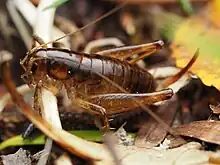| Hemiandrus brucei | |
|---|---|
 | |
| Scientific classification | |
| Domain: | Eukaryota |
| Kingdom: | Animalia |
| Phylum: | Arthropoda |
| Class: | Insecta |
| Order: | Orthoptera |
| Suborder: | Ensifera |
| Family: | Anostostomatidae |
| Genus: | Hemiandrus |
| Species: | H. brucei |
| Binomial name | |
| Hemiandrus brucei Taylor-Smith, Trewick, Morgan-Richards 2016 | |
Hemiandrus brucei is a species of ground wētā in the family Anostostomatidae endemic to New Zealand.[1] They are nocturnal and found in forests in the North Island and northern South Island.[1]
Taxonomy
Previously encompassed under Hemiandrus maculifrons, H. brucei is similar in appearance but genetically distinct. [1] H. brucei is named in memory of Briar Taylor-smiths grandfather, Bruce Edwin Smith. [1]
Habitat and distribution
Hemiandrus brucei is found in native forests in the North Island and northern South Island of New Zealand and is often sympatric with other wētā species.[1] Having such a broad range is uncharacteristic of most ground wētā, which are often endemic to very small areas.[2]
Morphology
Hemiandrus brucei has a high level of morphological variation.[1] The head and body of H. brucei is mostly brown but sometimes with small pale patches on the lateral and dorsal surfaces of the pronotum.[1] H. brucei has fine microsetae on the three apical segments of the maxillary palps; four spines on the inferior retro lateral angle of the mid tibiae; a single inferior articulated spine on the hind tibiae; males with a V- or U-shaped apical margin on the subgenital plate, blunt cerci, and ninth abdominal termite with two obtuse curved lobes; females with a long, gently curved ovipositor.[1]
Conservation
Hemiandrus brucei is classified as Not Threatened in the New Zealand Threat Classification System.[3]
Type information
- Taylor-Smith, BL; Trewick, SA; & Morgan-Richards, M (2016). Three new ground wētā species and a redescription of Hemiandrus maculifrons. New Zealand Journal of Zoology.
- Type specimen: adult female; March 2012; BL Taylor-Smith; deposited at the Museum of New Zealand Te Papa Tongarewa[1]
- Paratype: adult male, same collection data as holotype; deposited at the Museum of New Zealand Te Papa Tongarewa[1]
- Type location: Collected from the Kahuterawa Valley, Wellington −40.47190°, 175.61417° [1]
References
- 1 2 3 4 5 6 7 8 9 10 11 Taylor-Smith, BL; Trewick, SA; Morgan-Richards, M (2016-10-01). "Three new ground wētā species and a redescription of Hemiandrus maculifrons". New Zealand Journal of Zoology. 43 (4): 363–383. doi:10.1080/03014223.2016.1205109. ISSN 0301-4223. S2CID 88565199.
- ↑ "Meet Bruce, he's a musician". New Zealand Geographic. Retrieved 2023-05-02.
- ↑ Trewick, Steve; Hegg, Danilo; Morgan-Richards, Mary; Murray, Tara; Watts, Corinne; Johns, Peter; Michel, Pascale (2022). "Conservation status of Orthoptera (wētā, crickets and grasshoppers) in Aotearoa New Zealand, 2022" (PDF). New Zealand Threat Classification Series 39: 20.
